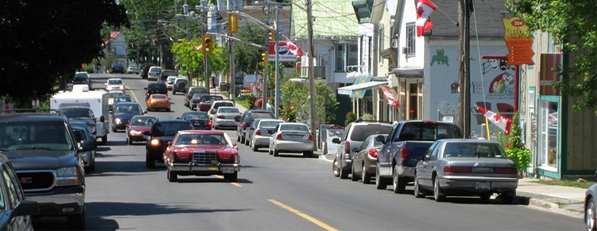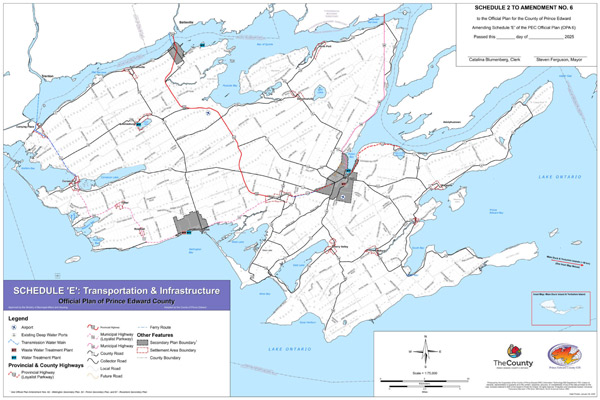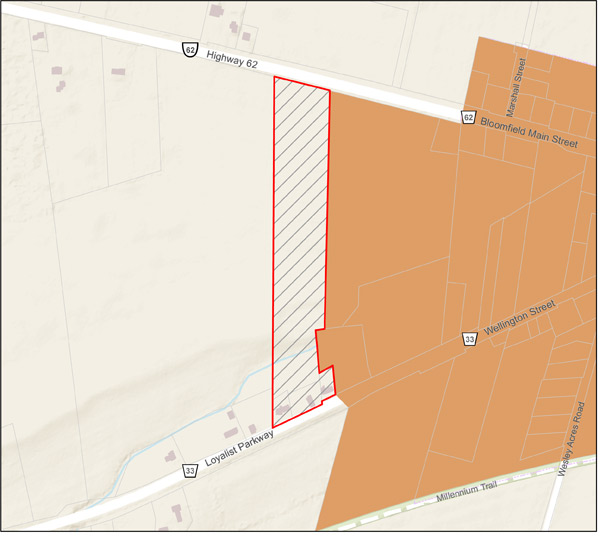Official plan amendments to align with updated provincial planning statement
Administrator | Mar 20, 2025 | Comments 0

The list of proposed changes includes things such as recognizing the approved Picton Main Street Heritage Conservation District and the new Wellington Heritage Conservation District with the addition of a new policy. New development would need to comply with the requirements of those heritage conservation districts.
By Sharon Harrison
Changes to Prince Edward County’s official plan to align with Ontario government policy were approved by council Wednesday at the planning and development committee meeting.
Intended as a general amendment, in short, the necessary changes will affect all properties in the municipality, to include various updates, such as permitting more additional dwelling units in rural areas, permitting changes to employment areas outside of comprehensive review, requiring development of an agricultural system to protect a municipality’s best farmland and agricultural assets, requiring buffers or mitigation measures for new employment areas, and allowing settlement boundary changes outside of a comprehensive review.
While council voted to approve the majority of the proposed changes, it also voted to remove a change to the Bloomfield boundary extension entirely, as well as refer the item for new lots to be supplied by one well, back to staff for further consideration on language wording.
The current proposed, municipality-initiated changes are intended to update the official plan to align it and ensure consistency with the updated provincial planning statement, the Ontario government’s policies on land use which was updated in 2024 to focus on building more homes. The general amendment also addresses changes made to the planning act and Ontario regulations, as well as local needs.
Prince Edward County’s official plan (OP), updated in February 2021, is a policy document to provide guidance when making decisions about proposed use of land. The Ontario government’s updated provincial planning statement (PPS 2024) came into effect in October 2024, and now applies to all municipal planning decisions.
Under a new two-step process (effective Jan. 1), details of the proposed planning update came before council at a first statutory overview meeting, held Feb. 5, (click here for details) intended as information-gathering only. Wednesday’s second meeting came with a report and recommendation from the development services department for council’s decision, and included further discussion and debate.
LEGISLATION AND REGULATION CHANGES
In his report to council, Scott Pordham, policy co-oordinator, notes two policy proposals relate to changes in legislation and regulation.
The first of these policy changes requires a municipality to review its official plan 10 years after it was passed, and every five years afterward, until a new official plan is adopted (previously, a review was required every five years).
The second of these changes proposes to address changes in Ontario regulation related to the heritage act that now requires new properties designated under the act to meet at least two of nine established criteria (previously, only one of nine criteria needed to be met).
OP POLICIES PROPOSED (greater detail below)
Several new official plan policies are also proposed, or existing policies are proposed to be amended, to address local needs or provide clarity to existing policies. As well, policies and definitions will be amended, deleted or included to provide clarity. The new OP policies proposed include:
-Proposed amendments to cultural heritage policies to recognize the new Wellington heritage conservation district.
-Additional policies are recommended to recognize the presence of the commercial fishery and provide direction when considering related development applications.
-A slight expansion of the Bloomfield village boundary is proposed to match lot lines and the settlement boundary.
-A change to the land development policies will clarify that new lots on private services need to be supplied by one single on-site private well, not multiple wells.
PPS 2024 CHANGES
The PPS 2024 now allows three dwellings on a property in agricultural areas, with the change intended to encourage the creation of additional housing.
“A new policy related to agriculture in the PPS 2024 mandates that two additional dwelling units be permitted in addition to the primary dwelling, with planning staff recommending that the additional dwelling units be permitted in both the agricultural and rural designations,“ Pordham said. “The change is hoped to address housing affordability and is therefore in line with the municipality’s strategic plan.“
Speaking to the two additional dwellings allowed in the rural areas (for a total of three), councillor Brad Nieman asked if there was a minimum lot size, where Pordham noted that under PPS 2024, lot size is not distinguished.
The report also states that boundaries of settlement areas may be changed at any time now, subject to criteria (under the previous 2020 PPS, settlement area boundaries could only be changed through a comprehensive review of the OP).
“The change meets the intent of the council priority to provide a supply of housing that is affordable,” notes Pordham.
Employment areas may be changed at any time, subject to criteria (under the previous 2020 PPS, employment area boundaries could only be changed through a comprehensive review).
New employment areas must now be in locations that ensure development within 300 metres avoid impacts on the long-term economic viability of the employment uses within existing or planned employment areas, otherwise measures are taken to minimize and mitigate potential impacts.
“The change is intended to protect employment areas by avoiding land use conflicts between industrial lands and sensitive land uses, and the policy change follows the municipality’s strategic plan and the objective to support a strong and diversified economy,” said Pordham.
Municipalities must now develop an agricultural system to protect prime agricultural lands and assets that support agriculture, which may include supporting uses such as processing, storage, and transportation facilities.
Examples might include wineries, cheese factories, canneries, abattoirs and other similar uses. The requirement for an agricultural system may limit development that would have a negative impact or threaten the viability of these uses.
“An agricultural system approach is now required under the new PPS, and the OP commits the municipality to developing an agricultural system based on provincial guidance.”
Pordham notes an agricultural system is defined in the PPS 2024 as:
-A system comprised of a group of inter-connected elements that collectively create a viable, thriving agri-food sector, with two components:
-An agricultural land-base comprised of prime agricultural areas, including specialty crop areas that may also include rural lands that help to create a continuous productive land base for agriculture; and
-An agri-food network which includes agricultural operations, infrastructure, services, and assets important to the viability of the agri-food sector.
Councillor Sam Branderhorst asked if staff will be going through the agricultural advisory committee to start the process there, or if not, how was staff planning to tackle it, where Pordham said he would imagine it would have go through the agricultural advisory committee.
“Maybe one thought would be that the agricultural committee would actually perhaps form a sub-committee to help develop it, but it has to be discussed with staff to determine what the best approach would be,” Pordham added.
Branderhorst indicated the sub-committee could collaborate with the Prince Edward Federation of Agriculture for a wider take, and “I know we have had our winery community feel left out from the agricultural advisory, so the more people we can get on this, the better.”
LOCAL NEEDS AMENDMENTS
Amendments related to local needs are at the discretion of council, notes Pordham.
“The municipality has approved heritage conservation districts (HCDs) for both Picton and Wellington that provide a framework for design proposals and decision making. The HCDs need to be recognized in the OP to ensure development applications are required to comply,” he explained.
Policies are proposed to recognize the commercial fishery in Prince Edward County based on comments from members of the public and a motion of council from October 2023. “The policies will prompt consideration for the industry when considering development proposals.”
He said, various sections of the OP are proposed to recognize the commercial fishery in Prince Edward County with the proposed changes to acknowledge that marine commercial businesses are to be encouraged as an objective of the rural policies, and specifically recognize commercial fishing as a permitted use in the rural designation.
Policy regarding consents is proposed to be amended by clarifying that new severances in rural areas are to be serviced by one well, and not multiple wells, along with the provision of an on-site sewage system.
“The PPS indicates that permitted uses on rural lands include residential development where site conditions are suitable for the provision of appropriate water and sewage services, and it indicates that development on rural lands shall be appropriate to the infrastructure which is planned or available,” notes the report.
“Furthermore, the PPS requires new land uses to comply with the minimum distance separation (MDS) formulae. The policies for agricultural areas in the PPS specifically permit two additional residential units, subject to various criteria, including compliance with the MDS formulae.”
Pordham said planning staff are recommending policy changes in the OP to correspond with the PPS for the additional dwelling units be permitted in both the agricultural and rural designations.
This discussion created some confusion among council as the proposed wording suggests only one well is permitted for one lot (of up to three dwellings), with no further wells or cisterns, etc. allowed.
Pordham explained that is not the case as the policy change is intended to clarify that at the time of severance, for instance, it would have to be demonstrated that one well could provide the water supply.
“That wouldn’t prevent someone from, at a future date, if they wanted to, if they felt the need to, they could do a second well, install a cistern, other measures as well,“ outlined Pordham. “So, it’s not that those are prohibited, it’s just that if somebody wants to create a lot, that’s were we would be looking for that one well to provide the water supply, to show that there is a good quantity of water at that point in time; it wouldn’t prevent them from doing more in the future.”
Councillor Kate MacNaughton said the language doesn’t make it clear that there could be options for additional wells in the future, “the language very specifically reads that each lot is permitted one well”.
MacNaughton put forward a motion to refer this item (and associated bylaw) back to staff for further consideration prior to approval (to come back to the March 25 council meeting), which council voted to approve.
A minor expansion of the Bloomfield village boundary was proposed so that it matches existing lot lines, but was not approved and was instead voted to be removed from the amendment.
“A relatively minor expansion of the Bloomfield village boundary is proposed on the west side of the settlement area to match the urban boundary with existing lot lines. The slight expansion includes three small residential lots along Loyalist Parkway and a portion of a vacant farm property fronting onto Highway 62,” Pordham outlined.
He said most of the farm property is already included in the village boundary, with the area of the farm property proposed to be included in the village boundary is approximately 100 metres wide and more than 400 metres deep, with a total developable area of about 3.6 hectares (9 acres).
“The proposed change will better facilitate development of the property by including it completely within the village boundary. Generally, it is preferable to match lot lines and urban boundaries where possible, and not exclude small, narrow strips of a property,” he explained.
“Staff feel the existing lot line and village boundary not being aligned is actually a deterrent to development of the property within the existing village boundary. In the opinion of staff, the minor boundary adjustment is in keeping with the policy and appropriate to facilitate development of the overall area.”
A member of the public, Harry Veenstra, who lives close to the Bloomfield boundary amendment being discussed, was not in agreement with the proposed boundary change.
He explained that he found out a few years ago that in 2021, the boundary line was moved from the east, about 100 metres or so to the west, and despite concerning his property, he had not been made aware of the change.
“Now they want to move it again, and if they moved it just four years ago, I don’t understand why they want to move it again, and I don’t know why that little bump-out was ever put in, I don’t get it, “expressed Veenstra. “I was told that they want to straighten the line up and they don’t want the farmer’s field on the south side of Highway 62 to be partially in Bloomfield and partially in Hallowell. Well, it is now, and it still will be, and I don’t know why they don’t follow the line of that farmer’s field.“
He said, if the land becomes part of Bloomfield instead of Hallowell, now it’s prime ag, and if it’s Bloomfield, he asked whether that makes it automatically future development and no longer prime ag.
“If it makes it future development, we are losing more farmland, but I have a problem with taking farmland and turning it into housing,” he said. “Losing farmland is not smart, and we have all kinds of scrubland in the County that could be housing over prime ag, so my concerns are, why are they moving it and what is the purpose?”
Responding to why this was being done, Pordham clarified that staff were trying to remove a deterrent of the larger of the four pieces in that area should someone want to develop it. “Two-thirds of the property is already in the urban boundary and could be developed. If someone wanted to come in and do that though, they would be left with a remnant parcel that they may or may not be able to do something with.”
Councillor Branderhorst agreed with Veenstra and put forward a motion to remove the proposed change to the Bloomfield boundary extension from the amendment, which council voted to approve. “We’ve heard a lot from staff about why this line is to be changed, but why move something that is not broken, and I propose to keep it as it is,” said Branderhorst.
 And finally, schedule E-transportation and infrastructure of the OP is to be amended to include the road networks in Picton, Wellington and Rossmore as it currently does not include these road networks, with the change consistent with the strategic plan objective to implement a long-term roads plan.
And finally, schedule E-transportation and infrastructure of the OP is to be amended to include the road networks in Picton, Wellington and Rossmore as it currently does not include these road networks, with the change consistent with the strategic plan objective to implement a long-term roads plan.
A bylaw to adopt is to be brought forward to the March 25 council meeting to be approved.
Filed Under: Featured Articles • Local News
About the Author:

































